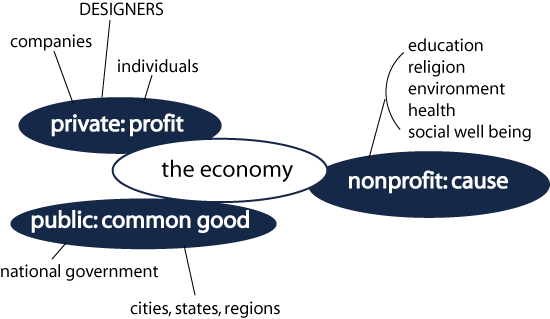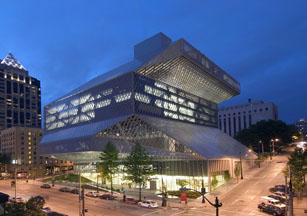I explain how I define activism in the “about & contact” page, but here I’m illustrating how activism fits into the economy. In this post I first describe the economy and design’s role in it, then I investigate how activism manifests itself within this framework.
The Economy
First, we have to recognize that the economy is bigger than the market — it has to be. The economy is a system for allocating resources, but there are many resources that we have, such as a temperate atmosphere, old growth forests, healthy children, diverse languages or democratic freedoms, that are very difficult to price. It is difficult and arguably even inappropriate to make money off of them. These resources and their value simply can’t be captured adequately in the private sector.
And guess what. Many of the things we’re aiming for with sustainability and sustainable design are just the sorts of things that aren’t captured by the market place.
If the economy is not the market, then what else is there? I suggest we need to think about a three-sector economy, as shown below.

The market place, often called the private sector, is obviously an important tool for exchanging goods and services. It is a powerful tool and we can direct it towards sustainable design. But it operates within the public sector, which sets the rules of the civilization game. But between these two sectors of the economy, some things still fall through the cracks -cancer research, world peace, saving the pandas, solving homelessness–these sorts of causes fall to the nonprofit sector.
We can then look at a new version of this diagram showing what we already know, design has traditionally been seen as a practice in the private sector. The diagram also shows a simplified version of what motivates each sector of the economy:

Although we have these three sectors of the economy to deal with all the resources we care about, in recent times there has been a great deal of pressure on us to equate well being with economic growth, which puts the private sector in the driver’s seat. Along with that it has become popular to argue that we should “let the market decide,” for example which products or buildings we should design.
But designers can actually work in all of these sectors. In the market place they can pursue the win-win design solutions that are good for sustainability and good for business, or they can develop market niches and pursue CSR. Patagonia is often cited as a good example.

The public sector provides ways to challenge the status quo — here is the Seattle public library, rated LEED silver, by Rem Koolhaus and LMN architecture.

Trailblazing public agencies can be progressive clients and they can set the bar higher for performance in sustainable design. On an individual level designers can pursue sustainability causes on their own pursuing altruism on their own time, often working in more of a artist mode. The example below is from Simon Heijdens; the ceramic pieces show the passage of time by very slowly revealing floral patterns in the glazing thus potentially motivating people to keep the pieces for longer (courtesy of the designer).

The nonprofit sector has been exploding over the past 25 years, and with it, a middle way is emerging for designers to pursue sustainable design. The nonprofit sector includes a wide range of groups and organizations – not least academia.
The project of the no wash shirt emerged among practitioner-researchers Kate Fletcher and Becky Early in an academic framework. But design work in the nonprofit sector can also take the form of advocacy, education, research, policy, services and the like.

In fact the number of nonprofit organizations has grown dramatically, especially during the last 25 years or so. the UN estimates there were about 1000 international nonprofit groups in 1941 and about 37000 in 2000, with 20% of those being formed in the 1990s. Some reasons for this include:
Activism
Here’s another way to look at it. Let’s consider the whole range of measures– financial, behavioral, environmental and so on–that are probably necessary to achieve sustainability – let these measures be the Y axis.

The market will automatically capture a certain amount of those measures that reduce costs or increase profits. For example, energy efficiency reduces costs and many measures such as daylighting and natural ventilation, also improve worker productivity. But even these benefits typically aren’t widely captured because of outdated practices (like over-engineering a building’s HVAC system) and institutional inertia.
In the end, for this reason and the reasons mentioned above, the market fails to capture sustainability measures beyond a certain point. At that point, we have government, which will require that market players take some actions. For example the government may set minimum standards. Or public policy might dictate that environmentally destructive practices will be more heavily taxed. Governments may also use motivational tactics: recommend certain practices and reward those who follow recommendations with awards and other incentives.
But in the end, governments still allow pollution, because minimum standards still allow some amount of emission/poor performance/toxins. Also government doesn’t enforce every rule and policy is heavily influence by the corporate finance of election campaigns and corporate lobbying. So government also fails to capture sustainability measures beyond a certain point.
At that point the third sector takes over. This sector is looking at the moral dimensions of the measures and pushing forward on those, not because those measures make money, not because they’re required, but because of a vision for the right thing to do.
Although each sector is typified by a certain behavior, and here I’ve called the behaviors competition (for profits), compliance (with regulations) and activism (doing the right thing), these behaviors can occur in any sector. For example, progressive businesses or governments might act on some moral issues, thus engaging in activism. Nonprofit groups might compete for members or foundation grants, and so on. Ray Anderson, of Interface Carpets, and the late Anita Roddick, of the Body Shop, are well-known corporate activists.
The relationship among these three sectors is dynamic. Activists take actions, such as protesting or demonstrating alternatives, so government changes regulation, requiring, let’s say, better environmental performance. This process gradually raises the bar so that businesses do more, governments change policy, and activism pursues yet new areas that have been neglected, but that need attention.
An important way for designers to address sustainability is for them to become activists. This might involve working in the nonprofit sector, for example:
For designers in a corporate setting becoming an activist might also mean helping to build the good company, asking the moral questions even in situations where they can’t necessarily be addressed. To keep raising the bar on which issues are addressed and how well they are addressed.